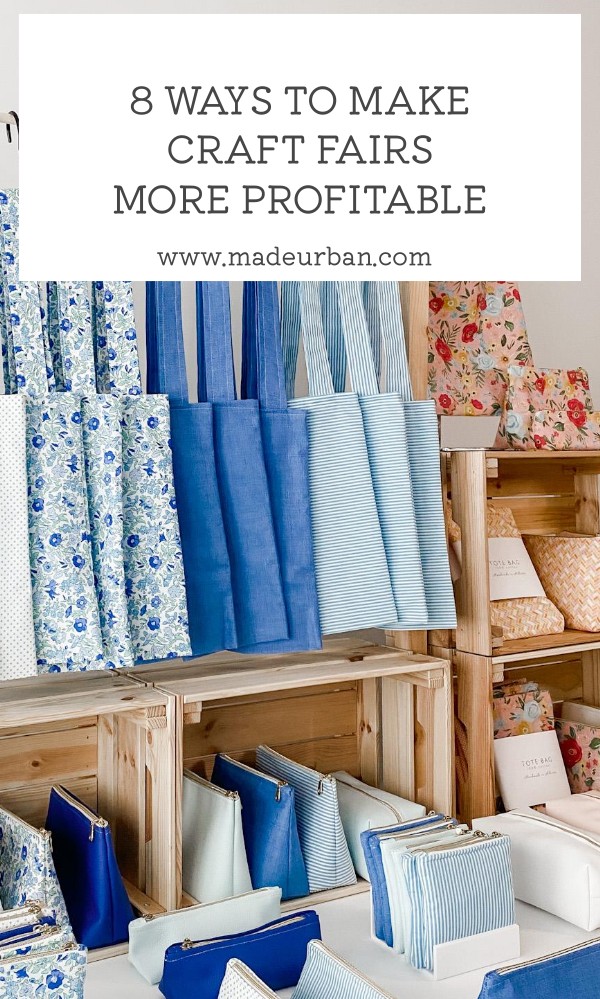8 Ways to Make Craft Fairs More Profitable
Sometimes, making more money at craft fairs doesn’t mean you need to sell more.
Here are some money-saving tips that will increase your profit margins so you walk away from an event with more money left in your pockets.

1 – Be smart with production costs
Always look for ways to reduce how much time and money you spend making your products, while keeping prices the same.
For example:
- Sign up for supply stores’ newsletters so you know when sales are running.
- Order enough quantities to qualify for free shipping.
- Source wholesalers and buy materials in bulk so you get wholesale pricing.
- Use tools that speed up your processes (e.g. I use a rotary cutter and cutting mat instead of scissors when cutting my pattern pieces. I also cut my pattern pieces out of thin cardboard so they can be used over and over).
- Refine your product line so you don’t require dozens of different materials.
- Streamline your designs and consider removing complicated elements that customers won’t miss.
- Batch your work so you speed up production.
2 – Make use of scraps
Think about smaller items you can make with your scrap materials that work with your existing products.
For example, I might make purse scarves from the fabric left after I cut out my purse linings.
Plan the use of your materials wisely, so you have less waste, and find ways to turn your “waste” into a sellable product.
3 – Save on overhead costs
Think about anything you spend time and money on for a craft fair and look for ways to cut those costs or reduce them.
For example:
- Stick to local craft shows so you save on travel and lodging costs.
- DIY your craft show fixtures and props.
- Share a booth with another business so you can split table fees.
- Carpool with another vendor to save on gas and parking.
- Bring snacks, drinks, and lunch.
4 – Get more of your customers to the event
This study suggests it’s 5 times more expensive to acquire a new customer than it is to retain an existing one.
Think about when you discover a new business versus when you head into your favourite store.
The new business needs to put in more effort to encourage you to buy than the business you trust and love.
When you have a shopper at your craft show table who has never heard of your business or purchased from you, you’ll need to spend more time explaining your products and brand, getting them to see your vision, etc.
That’s time taken away from other shoppers.
If you market the event to your existing customers (and fans) and get them to the event, you’ll require less effort selling to them.
Lower selling costs = higher profit margins.
4 – Bundle products
It’s also less expensive to sell 3 products to one customer than it is to sell 1 item to 3 customers.
The same number of items sold, but you’ll be more profitable if you can sell them in one transaction.
- Lower transaction fees
- Less packaging required (e.g. 1 shopping bag instead of 3)
- Less time spent selling
Group products together to encourage more shoppers to buy more than one item. Here’s how: How To Cross Merchandise in a Craft Show Display
5 – Offer upsell options
Once a shopper has decided to buy an item, a simple ask is to see if they’re interested in the bigger/better version.
For example, if someone is looking at a candle, “Do you want the bigger version for just $X more?” could encourage them to spend more money.
You’ve put in the same amount of effort for a bigger reward.
Consider adding variations of the products you already offer that allow shoppers to spend a little more and get a bigger or better version.
6 – Offer value-adds
Instead of offering discounts to shoppers, consider low-cost ways to add value to an order.
For example: “Get a free jewelry storage pouch when you spend $50.”
This is a good way to subtly encourage shoppers to spend a little more, with little effort/cost on your end.
7 – Lower transaction fees
Each time someone pays with a debit or credit card, you’re being charged a fee.
Shop around for the best payment processor with the lowest fees, and once you choose the best one, research ways you can reduce your fees.
For example, using a tap/chip reader can be cheaper than manual entry.
You may also encourage customers to pay cash or with e-transfer.
8 – Focus on high profit margin products
It’s important to look at your numbers after each craft show and know not only what your bestsellers are, but also which products you sell the most of that have the highest profit margins.
The more you highlight and promote your high profit margin bestsellers, the more you’ll sell of them.
Here are important metrics to track at craft shows: 7 Stats to Track at Craft Shows (to improve sales)

Hey, I’m Erin 🙂 I write about small business and craft show techniques I’ve learned from being a small business owner for almost 2 decades, selling at dozens of craft shows, and earning a diploma in Visual Communication Design. I hope you find my advice helpful!
